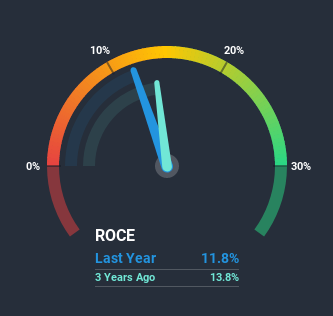- India
- /
- Electrical
- /
- NSEI:PITTIENG
What Do The Returns On Capital At Pitti Engineering (NSE:PITTIENG) Tell Us?

If we want to find a potential multi-bagger, often there are underlying trends that can provide clues. Typically, we'll want to notice a trend of growing return on capital employed (ROCE) and alongside that, an expanding base of capital employed. Ultimately, this demonstrates that it's a business that is reinvesting profits at increasing rates of return. Although, when we looked at Pitti Engineering (NSE:PITTIENG), it didn't seem to tick all of these boxes.
What is Return On Capital Employed (ROCE)?
For those that aren't sure what ROCE is, it measures the amount of pre-tax profits a company can generate from the capital employed in its business. To calculate this metric for Pitti Engineering, this is the formula:
Return on Capital Employed = Earnings Before Interest and Tax (EBIT) ÷ (Total Assets - Current Liabilities)
0.12 = ₹363m ÷ (₹6.0b - ₹2.9b) (Based on the trailing twelve months to June 2020).
Therefore, Pitti Engineering has an ROCE of 12%. That's a relatively normal return on capital, and it's around the 10% generated by the Electrical industry.
View our latest analysis for Pitti Engineering

While the past is not representative of the future, it can be helpful to know how a company has performed historically, which is why we have this chart above. If you're interested in investigating Pitti Engineering's past further, check out this free graph of past earnings, revenue and cash flow.
What Does the ROCE Trend For Pitti Engineering Tell Us?
On the surface, the trend of ROCE at Pitti Engineering doesn't inspire confidence. To be more specific, ROCE has fallen from 18% over the last five years. And considering revenue has dropped while employing more capital, we'd be cautious. If this were to continue, you might be looking at a company that is trying to reinvest for growth but is actually losing market share since sales haven't increased.
On a side note, Pitti Engineering has done well to pay down its current liabilities to 48% of total assets. So we could link some of this to the decrease in ROCE. What's more, this can reduce some aspects of risk to the business because now the company's suppliers or short-term creditors are funding less of its operations. Some would claim this reduces the business' efficiency at generating ROCE since it is now funding more of the operations with its own money. Either way, they're still at a pretty high level, so we'd like to see them fall further if possible.What We Can Learn From Pitti Engineering's ROCE
In summary, we're somewhat concerned by Pitti Engineering's diminishing returns on increasing amounts of capital. Investors haven't taken kindly to these developments, since the stock has declined 27% from where it was five years ago. That being the case, unless the underlying trends revert to a more positive trajectory, we'd consider looking elsewhere.
One final note, you should learn about the 5 warning signs we've spotted with Pitti Engineering (including 1 which is is significant) .
If you want to search for solid companies with great earnings, check out this free list of companies with good balance sheets and impressive returns on equity.
If you’re looking to trade Pitti Engineering, open an account with the lowest-cost* platform trusted by professionals, Interactive Brokers. Their clients from over 200 countries and territories trade stocks, options, futures, forex, bonds and funds worldwide from a single integrated account. Promoted
New: Manage All Your Stock Portfolios in One Place
We've created the ultimate portfolio companion for stock investors, and it's free.
• Connect an unlimited number of Portfolios and see your total in one currency
• Be alerted to new Warning Signs or Risks via email or mobile
• Track the Fair Value of your stocks
This article by Simply Wall St is general in nature. It does not constitute a recommendation to buy or sell any stock, and does not take account of your objectives, or your financial situation. We aim to bring you long-term focused analysis driven by fundamental data. Note that our analysis may not factor in the latest price-sensitive company announcements or qualitative material. Simply Wall St has no position in any stocks mentioned.
*Interactive Brokers Rated Lowest Cost Broker by StockBrokers.com Annual Online Review 2020
Have feedback on this article? Concerned about the content? Get in touch with us directly. Alternatively, email editorial-team@simplywallst.com.
About NSEI:PITTIENG
Pitti Engineering
Manufactures and sells iron and steel engineering products in India.
Excellent balance sheet with reasonable growth potential.
Market Insights
Community Narratives



